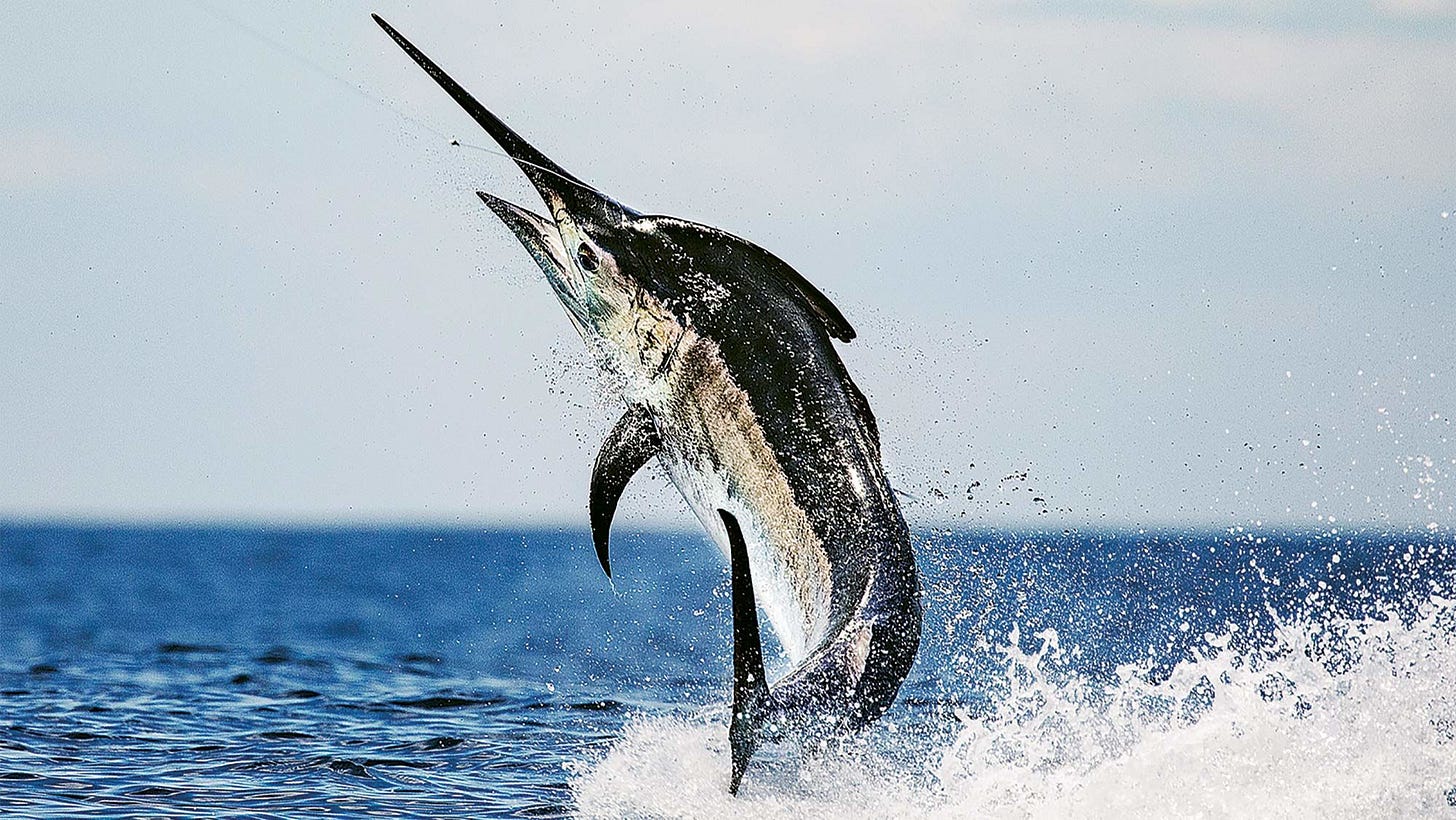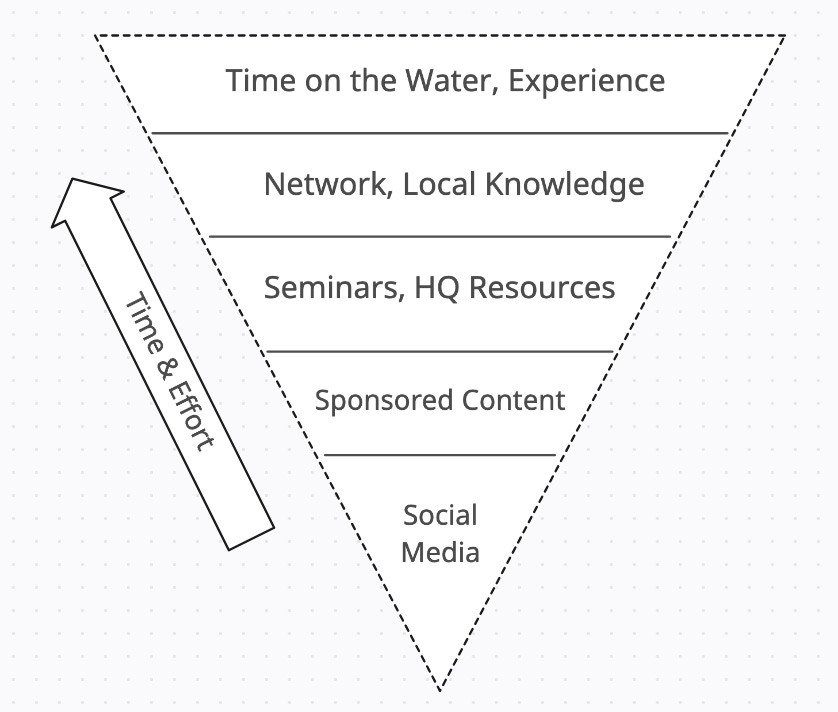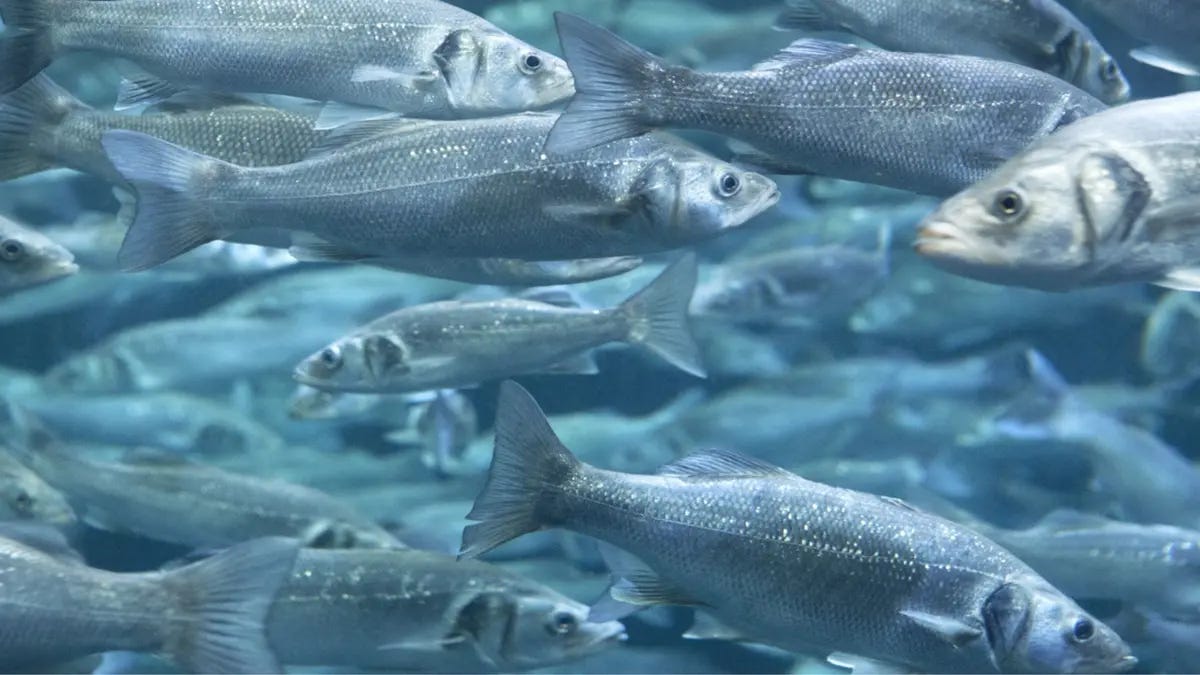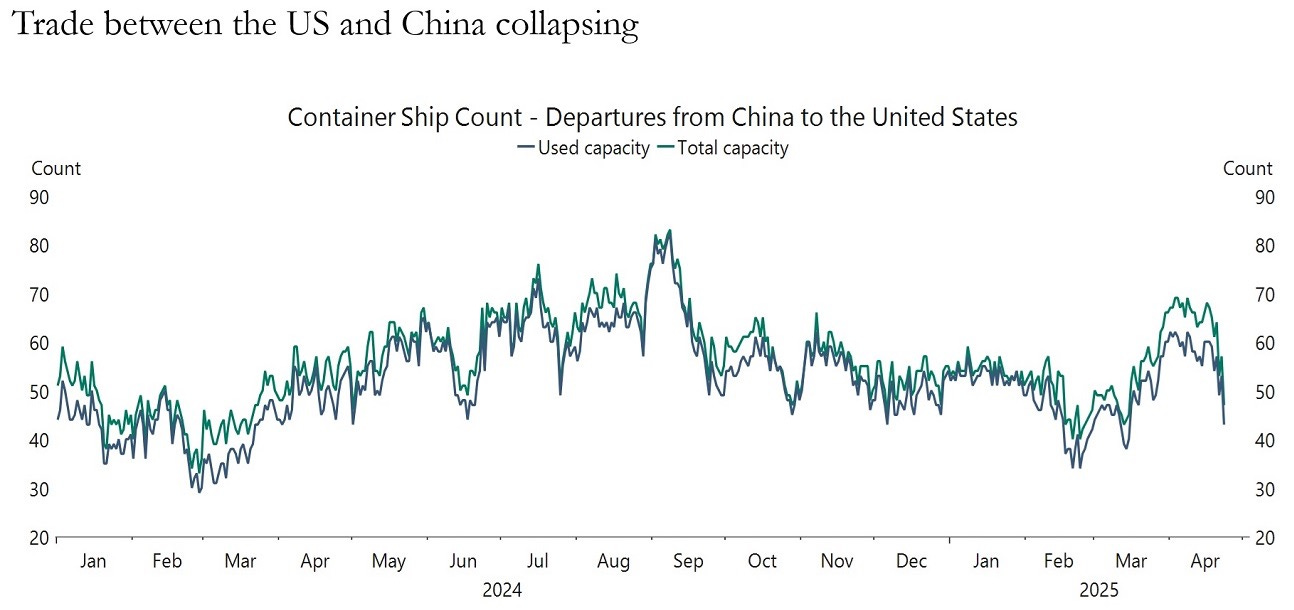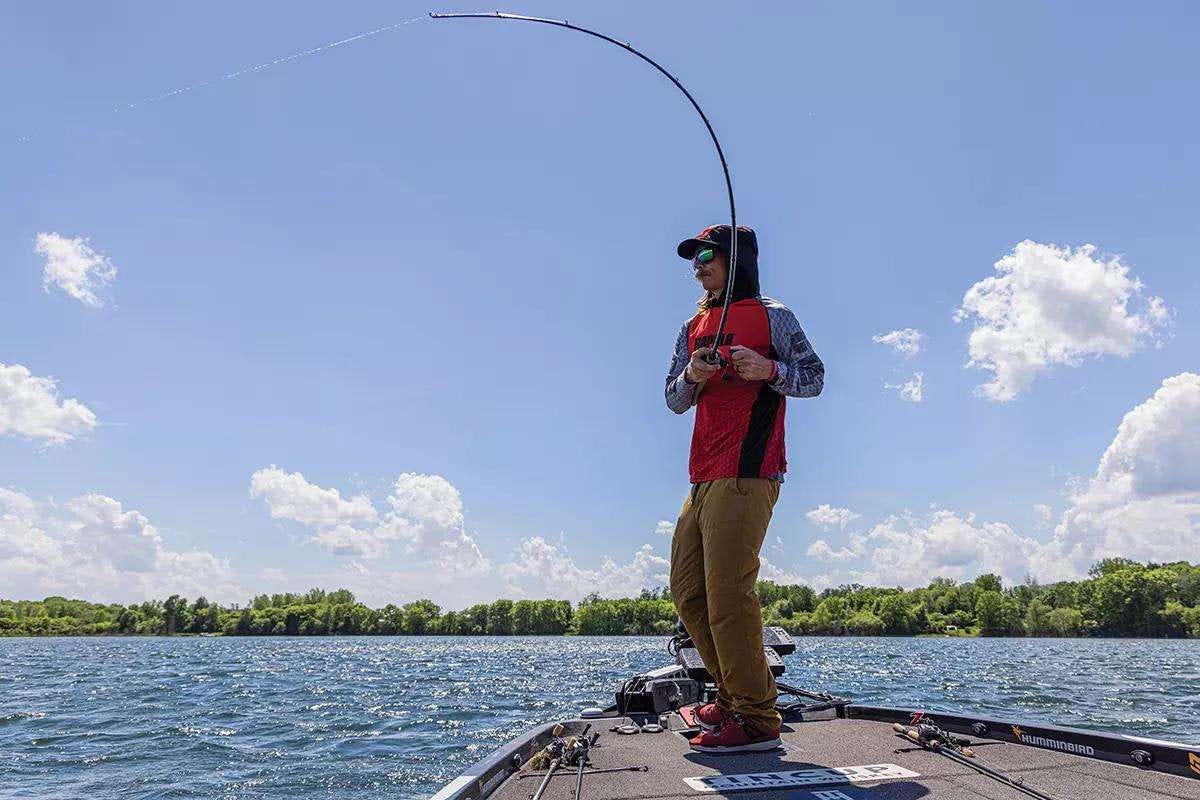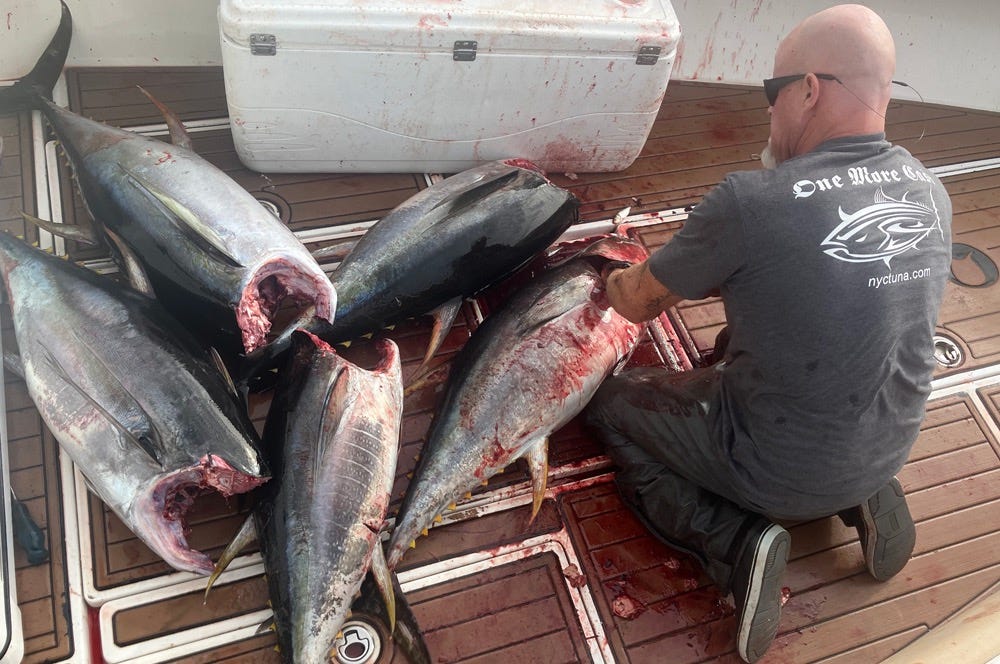The maritime rule of salvage has its origin in Roman law, which dictates that one who preserves or improves upon the misplaced property of another is owed compensation, even if the service was not requested. Let’s get out the internet trawler and get to work…
🎙️| The Saltwater Edge Podcast: Ralph Craft of CraftyOne Customs —> Two pillars of the Northeast saltwater scene discuss the importance of community-based decision-making and how supporting local business (tackle shops, builders and charter operations) is paramount to defending our right to enjoy the outdoors. Highly encourage listening to this one.
🎥 | Black Marlin of Cairns —> An evergreen reminder that fishing off the hard edge of the Great Barrier Reef (one of the seven natural wonders of the world) is unlike anywhere else.
Fishing Reports | OnTheWater - FishermanMag - HullTruth - SOL
Renew your HMS vessel permits here.***
Gear Guide by Tak Waterman | Striper Camo Snapback
Description | While I’m not superstitious, I am a lil-stitious, and nothing gets me more fired up more than searching for my new ‘lucky hat’ each season. With migratory Striped Bass flying up the salt coast, this buoyant (major key!) and breathable corded snap-back might just be the one for you. Ya never know.
Fishing Philosophy: Stair Steps on the Slope of Enlightenment
About a year ago to the day, we discussed the subtle art and junk science of learning how to fish. Our framework was the acclaimed Dunning-Kruger Curve (seen below) — a measure of competence and confidence — which some might immediately recognize as the progression from the “beginners luck” phase to the “I suck and wanna sell all my gear” rut, to becoming consciously competent and finally approaching the nirvana of “that son of a bitch is just fishy” status.
A dozen moons ago, we focused on the best avenues to focus your time and effort, noting the rewards of T.O.T.W. and the pitfalls of sponsored content and social media click-bait…
In this installment, we’ll offer some more practical advice on climbing the very slippery slope of enlightenment, recognizing that our own experiences and mistakes are the primary driver of future successes.
Trends, Not Snapshots: Anglers tend to focus too much on the ‘current’ weather, wind direction or water temperature instead of the trends over the last 2–3 days (e.g., dropping pressure or rising overnight temps). In the same way, a static barometric pressure reading might be useful, but not as useful as knowing when that reading is set to rise or begin rapidly falling during the day, trigger feeding windows.
Micro & Macro: Anglers might nail the big trend (wind, bait, tide, moon), but ignore how micro conditions like shade-lines, channels, bars, reefs, or points might fish differently during similar weather conditions.
Water Layers: Fisherman often anchor on surface temperature, missing the fact that fish may key in on specific thermoclines or temperature breaks well below the surface. In estuarine or inshore systems, they might also ignore how heavy rains, droughts, or water movement can change salinity and oxygen levels — making some spots ‘go dead’ seemingly overnight.
Electronic Avenue: Most anglers have enough familiarity with their electronics, namely sonar, to distinguish the differences between bait and gamefish ‘marks’. Where the best anglers separate themselves is being able to determine the “attitude” of gamefish based on their movements / relation to depth contours and structure, and alter their presentations in real-time to take advantage.
Lunar Build-Up: Any half-decent fisherman can tell you where they’ll be at full or new moon phases, but they might not factor in the days leading up to and following these phases, which often produce great fishing. Additionally, many focus only on the moon phase, not the exact major and minor solunar periods, which might shift fish location intra-day or night.
Cloud & Daylight Cycles: Anglers typically prepare presentations for a cloudy or sunny day, but might miss how extended cloudiness, fog or sudden sunshine might shift fish activity, sometimes delaying (or extending) peak feeding times. Similarly, they might ignore how the intra-day shift in sun angles impact fish positioning and travel in mornings vs evenings.
If you now have more questions than answers swirling around in your subconscious, good. The first sign that you’re leaving the valley of despair is recognizing your genuine passion for fishing will not end in mastery, but the humbling awareness of just how little you’ll ever truly know. In Masshole terms, its kinda like the Karen Read Case…the more evidence that turns up, the more you have no freaking clue whether she did it or not, but you’re absolutely sure that people from Canton are totally fucking nuts (…although I’m like 98% sure they framed her drunken ass).
French team plans to hatch fish in space to test future Moon-based aquaculture (InterestingEngineering) - “Now that tomatoes, lettuce, potatoes, and other veggies have been cultivated in space, how soon might astronauts begin raising fish on the ISS or the Moon? For the last few years, the innovative Lunar Hatch project has been raising the possibility of space-based fish farming. This ambitious project aims to prove the feasibility of sea bass aquaculture as a sustainable food solution for future Moon and Mars missions. If all goes as planned, the Lunar Hatch could provide sea bass at least twice a week for the lunar inhabitants.” —> Now if I’m not mistaken, this is basically the exact plot of the sci-fi horror film “Life” (2017), where the martian life-form ends up eating the crew of the International Space Station and then escapes to Earth…but yeah let’s do it!
How To Beat Tariff-Driven Fishing Lure Price Hikes (Wired2Fish) - “A lot of products in the fishing market are obviously produced in China. At the time of writing this, there’s a 145% tariff on these products. Just doing quick math, to maintain the same profit margin percentage-wise, I believe that puts a $5 crankbait at around $12.25. Now, we haven’t seen any price hikes quite that dramatic yet, but the prices are certainly creeping up as companies try to soften the blow for their consumers while simultaneously protecting their bottom lines as best they can, with no certainty of how long the tariffs and price hikes will last. There’s a tendency to think, “We’ll just buy American.” But many products that are technically made in the US, such as fishing rods with blanks built here but are outfitted with Fuji guides which are made in Japan, still have materials that are coming from overseas. Those raw materials are subject to the tariffs, too.” —> As predicted a few weeks ago, the stories around merchandise shortages in the outdoor / recreational economy are beginning to proliferate as the hard truth sets in (see below). Bottom-line, the supply chains surrounding our favorite pursuit are once again about to get bumpy, so it’s high time to go support a local shop, build up some inventory of your go-to items, and give the nod to US-based brands to help them weather the storm over the next few months.
Fishing Bucktails for Striped Bass When Marking Them Below You (JBHBucktails) - “Drop the bucktail straight down until it hits bottom, then crank up just a turn or two to keep it slightly above the bottom. To work the bucktail in the most effcient way you want to give it a jig motion without any frantic movements. Many strikes will come on the fall, so stay alert—watch your line for twitches or sudden stops. When a striper bites, especially on the drop, setting the hook with authority is key. Don’t wait to "feel it out"—stripers have tough mouths, so give a hard upward sweep to drive the hook home. Using a medium-heavy spinning or conventional rod is best, around 6’6” to 7’, with fast action for strong hooksets. Spool your reel with 30–40 lb braided line for sensitivity and strength, and tie on a 3-foot 30–40 lb fluorocarbon leader using a strong knot like the FG or Alberto.”
How to Handle Windy Conditions While Bass Fishing (Game&Fish) - “Springtime bass fishing in the Midwest can be difficult, due in no small part to the weather systems pushing through the region this time of year. Winds, sometimes excessive, often accompany these fronts and can frustrate angler efforts. Successfully fishing in windy conditions isn’t about toughness. Rather, it’s about recognizing the real-world impacts of wind and how they influence your angling objectives. While an angler’s personal comfort matters somewhat, how bass respond to wind is far more important.”
Blood on My Hands (AnglersJournal) - “It’s easy to be a conservationist at a computer. If you spend time on the water, it’s a hell of a lot more difficult because even when releasing fish you will gut- or gill-hook a few. While I often say “crabs gotta eat too,” it doesn’t feel right. And if you’re a charter captain, even a light-tackle specialist, you’re going to get guys who want to take home a “limit.” Occasionally my conscience gets to me, and I feel like I’m part of the problem, especially when clients want to kill everything. When you have enough yellowfin in the box to feed the neighborhood, you don’t need more. Things have gotten uncomfortable on my boat when I put the brakes on overindulgence.”
Looking for more information about a product after reading The Weekly Salvage?
Try using GearSay, the first generative AI tool specifically tailored to help you find the right fishing tackle.
Type in a question like “what are the best US-based rods builders for light-tackle Striped Bass?" to get instant results.
Thanks for reading The Weekly Salvage, until next week!
Have feedback or want to learn more?
Reach out to us on IG @Blowin_We_Goin



